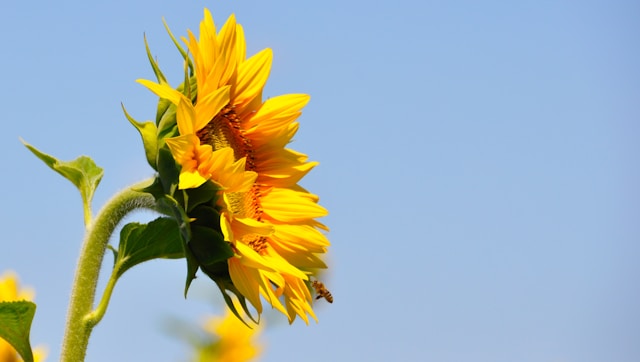How Late Can You Plant Sunflowers: A Detailed Guide
Introduction
Sunflowers (Helianthus annuus) are one of the most recognizable and beloved flowers in the world. Known for their tall, stately stalks and large, bright yellow blooms, sunflowers are a favorite among gardeners and farmers alike. While many people associate sunflowers with the height of summer, it’s a common question: how late can you plant sunflowers and still enjoy their beauty and benefits? This article will explore the various factors that influence the latest planting dates for sunflowers, including climate, variety, and intended use.
Understanding Sunflower Growth
Before delving into the specifics of “How Late Can You Plant Sunflowers,” it’s important to understand the basic growth cycle of sunflowers. Sunflowers are annual plants, meaning they complete their life cycle in one growing season. The general stages of sunflower growth include:
- Germination: The seed absorbs water and begins to grow. This stage usually takes about 7 to 10 days.
- Vegetative Growth: The plant develops its stalk, leaves, and roots. This stage can last from 30 to 40 days.
- Budding: The flower bud forms and grows. This typically takes about 20 days.
- Flowering: The sunflower blooms, usually lasting 10 to 14 days.
- Maturation: The seeds develop and mature. This stage can take anywhere from 30 to 45 days.
The entire process from planting to seed maturation can take between 70 to 100 days, depending on the variety and growing conditions. This timeline is crucial when considering late planting.

Factors Influencing Late Planting
Several factors influence how late you can plant sunflowers, including climate, sunflower variety, and the intended use of the sunflowers.
1. Climate and Growing Zone
Climate is the most significant factor in determining how late you can plant sunflowers. Sunflowers thrive in warm weather and need full sun to grow properly. They are sensitive to frost, which can damage or kill the plants.
a. Frost Dates
The first step in determining your latest planting date is to know your area’s average first frost date in the fall. Sunflowers need to mature before the frost to ensure a successful harvest. You can find frost date information from local agricultural extensions or gardening websites.
b. Growing Season Length
The length of your growing season (the number of frost-free days) will dictate how late you can plant. In regions with a long growing season (200 or more frost-free days), you can plant sunflowers as late as July or even early August. In regions with a shorter growing season (100 to 150 frost-free days), planting sunflowers after mid-June may be risky.
2. Sunflower Variety
Different sunflower varieties have different growth requirements and timelines. Some varieties mature faster than others, which can be beneficial for late planting.
a. Early-Maturing Varieties
Early-maturing sunflower varieties can go from planting to maturity in as little as 70 days. These varieties are ideal for late planting, as they have a shorter growth cycle. Examples include ‘Sunspot’ and ‘Big Smile.’
b. Mid-Season Varieties
Mid-season varieties take around 80 to 90 days to mature. While not as fast as early-maturing varieties, they can still be a good option for late planting in areas with longer growing seasons. Examples include ‘Mammoth’ and ‘Autumn Beauty.’
c. Late-Maturing Varieties
Late-maturing varieties take 100 days or more to mature and are generally not suitable for late planting. These varieties are best planted in early to mid-spring to ensure they have enough time to develop fully. Examples include ‘Russian Giant’ and ‘Titan.’
3. Intended Use
The intended use of your sunflowers can also influence your planting timeline. Sunflowers can be grown for their ornamental value, seeds, or as a cover crop.
a. Ornamental Use
If you’re growing sunflowers primarily for their aesthetic value, you have more flexibility with planting dates. As long as the flowers bloom before the first frost, you can enjoy their beauty in your garden. For ornamental use, late planting in July or early August can still yield beautiful blooms.
b. Seed Production
For sunflower seeds, whether for human consumption or bird feed, timing is more critical. The seeds need enough time to mature fully before the first frost. Therefore, planting sunflowers for seeds should be done no later than mid-July in most regions.
c. Cover Crop
Sunflowers can be used as a cover crop to improve soil health and structure. When used as a cover crop, the goal is to maximize biomass production rather than flower or seed production. In this case, planting sunflowers later in the season (late July or August) can still be beneficial, as long as they have enough time to grow before frost.
Late Planting Tips
If you decide to plant sunflowers later in the season, there are several tips to help ensure a successful late planting:
1. Choose the Right Variety
Opt for early or mid-season sunflower varieties that mature quickly. This will increase the likelihood that your sunflowers will have enough time to develop fully before the first frost.
2. Prepare the Soil
Sunflowers prefer well-drained soil with a pH between 6.0 and 7.5. Ensure your soil is well-prepared before planting by incorporating organic matter and ensuring good drainage.
3. Provide Adequate Water
Sunflowers need consistent moisture, especially during germination and early growth stages. Ensure your late-planted sunflowers receive enough water, but avoid overwatering, which can lead to root rot.
4. Monitor for Pests and Diseases
Late planting can sometimes coincide with peak pest activity. Monitor your sunflowers regularly for signs of pests such as aphids, caterpillars, and beetles, as well as diseases like downy mildew and rust.
5. Support Taller Varieties
If you’re planting taller sunflower varieties, provide support to prevent them from toppling over, especially in areas prone to late-season storms or strong winds.
Regional Considerations
Different regions have unique climates and growing conditions that affect late sunflower planting. Here are some regional considerations:
1. Northern United States
In northern regions with shorter growing seasons, such as the northern Midwest and Northeast, late planting should be done with caution. The latest planting date is typically early July, with a preference for early-maturing varieties.
2. Southern United States
The southern United States, including states like Texas, Florida, and Louisiana, has longer growing seasons, allowing for later planting. Sunflowers can often be planted as late as August, taking advantage of the extended warm weather.
3. Western United States
The western United States has diverse climates, from the cool coastal areas to the hot, arid regions. Coastal areas with mild summers can accommodate later planting, while hotter inland areas should consider the heat stress on late-planted sunflowers.
4. Midwest United States
The Midwest, with its moderate growing season, typically allows for late planting until mid-July. Early and mid-season varieties are recommended to ensure successful maturation before frost.
Success Stories and Case Studies
Hearing about real-world experiences can be helpful in understanding the possibilities and limitations of late sunflower planting. Here are a few success stories:
1. A Community Garden in Minnesota
In a community garden in Minneapolis, Minnesota, gardeners planted sunflowers in mid-July after an early crop of vegetables was harvested. They chose an early-maturing variety and were able to enjoy vibrant blooms by late September, just before the first frost.
2. A Family Farm in Texas
A family farm in central Texas successfully planted sunflowers in early August as a cover crop. The sunflowers thrived in the warm climate and provided excellent biomass, which was tilled into the soil to improve fertility for the next planting season.
3. An Urban Garden in California
In San Francisco, California, an urban garden planted sunflowers in late July. The mild coastal climate allowed the sunflowers to grow and bloom well into October, providing a beautiful display for the community.
Additional Considerations
1. Soil Preparation and Amendments
Late planting requires extra attention to soil preparation. Sunflowers grow best in loose, well-draining soil. If planting late, ensure that your soil is free of weeds and has been enriched with compost or other organic matter to support rapid growth. Soil temperature is also crucial; sunflower seeds germinate best in soil temperatures between 70°F and 78°F. If planting later in the summer, ensure the soil temperature is adequate for quick germination.
2. Fertilization
Sunflowers are heavy feeders and may require additional fertilization, especially when planted late in the season. Use a balanced fertilizer at planting time to give the plants a good start. Follow up with a high-nitrogen fertilizer during the vegetative growth stage to support robust stem and leaf development.
3. Irrigation
Proper irrigation is essential for late-planted sunflowers, particularly in areas experiencing high summer temperatures. Sunflowers need about 1 inch of water per week. Consistent watering is vital during germination and early growth stages. Mulching around the base of the plants can help retain soil moisture and reduce weed competition.
4. Pest and Disease Management
Late planting can expose sunflowers to different pest and disease pressures. Common pests include aphids, caterpillars, and beetles. Regular inspection and prompt action, such as using insecticidal soap or neem oil, can help manage infestations. Fungal diseases like powdery mildew and downy mildew can also be a concern, especially in humid climates. Proper spacing to ensure good air circulation and the use of fungicides when necessary can mitigate these risks.
5. Harvesting and Post-Harvest Care
For those growing sunflowers for seeds, timing the harvest is crucial. Seeds should be harvested when the back of the flower head turns yellow and the seeds are plump and hard. Cut the heads off with about a foot of stem attached and hang them in a dry, well-ventilated area to cure. For ornamental sunflowers, cutting the flowers when they just begin to open will ensure the longest vase life.
Environmental and Sustainability Considerations
Growing sunflowers, even late in the season, can have positive environmental impacts. Sunflowers are excellent at improving soil health and structure. Their deep roots can break up compacted soil and increase organic matter. Additionally, sunflowers attract pollinators such as bees and butterflies, which are essential for a healthy garden ecosystem.
1. Soil Health
Late-planted sunflowers can be an effective cover crop. They help prevent soil erosion, increase organic matter, and improve soil structure. After harvesting the flowers or seeds, the remaining plant material can be composted or tilled back into the soil to add nutrients and improve soil fertility.
2. Pollinator Support
Sunflowers are a valuable resource for pollinators. Planting sunflowers late in the season can provide a crucial food source for bees and other pollinators when other flowers have finished blooming. This can help support local pollinator populations and contribute to overall garden health.
3. Wildlife Habitat
In addition to supporting pollinators, sunflowers can provide habitat and food for various wildlife species. Birds, in particular, enjoy sunflower seeds. Leaving some seed heads on the plants through the winter can provide a natural food source for birds and other wildlife.
Cultural and Historical Significance
Sunflowers hold cultural and historical significance in many parts of the world. Native to North America, sunflowers were cultivated by indigenous peoples long before European settlers arrived. They were used for food, oil, and dye, and they held spiritual significance in many cultures.
1. Native American Uses
Native American tribes such as the Hopi, Navajo, and Sioux cultivated sunflowers for their seeds, which were an important food source. They also extracted oil from the seeds for cooking and medicinal purposes. The vibrant petals were used to create dyes for textiles and artwork.
2. European Cultivation
When sunflowers were brought to Europe by Spanish explorers in the 16th century, they quickly gained popularity. They were initially grown as ornamental plants, but their value as a source of oil was soon recognized. By the 19th century, sunflowers were widely cultivated in Russia for their oil, which remains a major use today.
3. Modern Symbolism
In modern times, sunflowers have become a symbol of positivity, happiness, and resilience. They are often used in art, literature, and celebrations to convey these themes. Their bright, cheerful appearance makes them a favorite in gardens and floral arrangements around the world.
Conclusion
The question of how late you can plant sunflowers depends on several factors, including your climate, the sunflower variety, and your intended use. By understanding these factors and following best practices for late planting, you can enjoy the beauty and benefits of sunflowers even when planting later in the season.
In summary:
- Climate and frost dates are critical in determining the latest planting date.
- Early and mid-season varieties are best for late planting.
- Intended use (ornamental, seed production, cover crop) influences planting decisions.
- Regional considerations help tailor your approach to local conditions.
- Late planting tips can improve your chances of success.
By carefully considering these factors and planning accordingly, you can successfully grow sunflowers and enjoy their bright, cheerful presence in your garden, even with a late start. Sunflowers not only enhance the beauty of your garden but also contribute positively to the environment and local ecosystem. Whether you are planting them for their stunning flowers, nutritious seeds, or beneficial impact on the soil and pollinators, sunflowers are a versatile and rewarding addition to any garden.




Leave a Reply